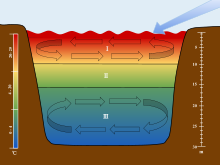
I. The Epilimnion
II. The Metalimnion
III. The Hypolimnion
The scales are used to associate each section of the stratification to their corresponding depths and temperatures. The arrow is used to show the movement of wind over the surface of the water which initiates the turnover in the epilimnion and the hypolimnion.
| Lake zones |
|---|
| Lake stratification |
| Lake types |
| See also |
The epilimnion or surface layer is the top-most layer in a thermally stratified lake.
The epilimnion is the layer that is most affected by sunlight, its thermal energy heating the surface, thereby making it warmer and less dense. As a result, the epilimnion sits above the deeper metalimnion and hypolimnion, which are colder and denser. [1] Additionally, the epilimnion is typically has a higher pH and higher dissolved oxygen concentration than the hypolimnion.
- ^ Haddout, Soufiane; Qanza, Hamid; Guennoun, Mohamed; Azidane, Hind; Karra, Rachid; Essaidi, Amine (31 July 2018). "Epilimnion and metalimnion thermal water temperature variables in Moroccan's Lakes using a one-dimensional fresh-water lake model". International Journal of River Basin Management. 18 (3): 321–333. doi:10.1080/15715124.2018.1498854. S2CID 134624630.